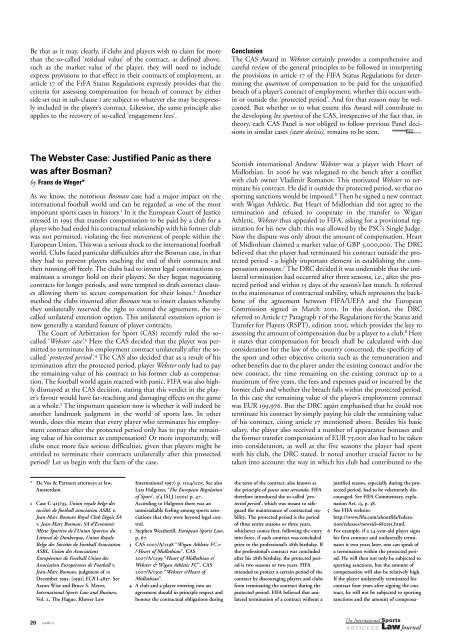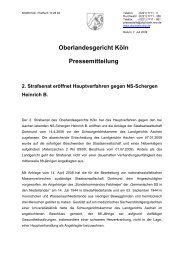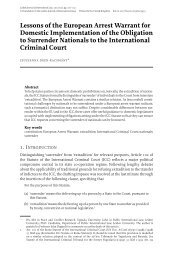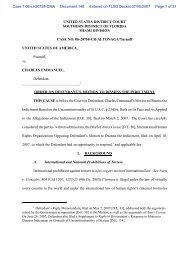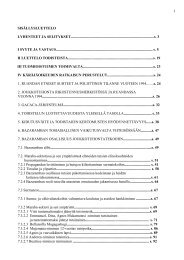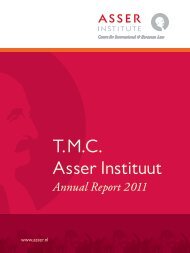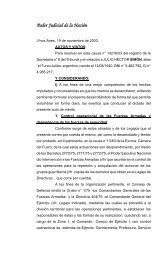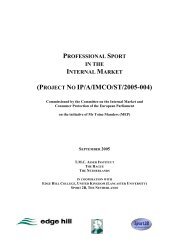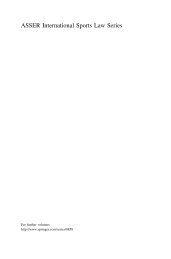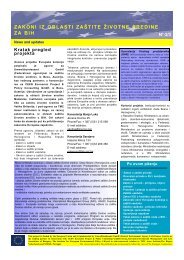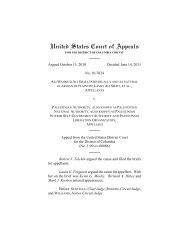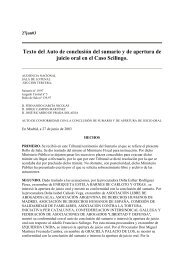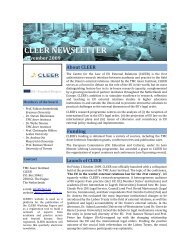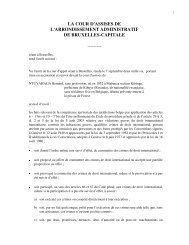Be that as it may, clearly, if clubs and players wish to claim for morethan the so-called ‘residual value’ of the contract, as defined above,such as the market value of the player, they will need to includeexpress provisions to that effect in their contracts of employment, asarticle 17 of the F1FA Status Regulations expressly provides that thecriteria for assessing compensation for breach of contract by eitherside set out in sub-clause 1 are subject to whatever else may be expresslyincluded in the player’s contract. Likewise, the same principle alsoapplies to the recovery of so-called ‘engagement fees’.ConclusionThe CAS Award in Webster certainly provides a comprehensive andcareful review of the general principles to be followed in interpretingthe provisions in article 17 of the FIFA Status Regulations for determiningthe quantum of compensation to be paid for the unjustifiedbreach of a player’s contract of employment, whether this occurs withinor outside the ‘protected period’. And for that reason may be welcomed.But whether or to what extent this Award will contribute tothe developing lex sportiva of the CAS, irrespective of the fact that, intheory, each CAS Panel is not obliged to follow previous Panel decisionsin similar cases (stare decisis), remains to be seen.The Webster Case: Justified Panic as therewas after Bosman?by Frans de Weger*As we know, the notorious Bosman case had a major impact on theinternational football world and can be regarded as one of the mostimportant sports cases in history. 1 In it the European Court of Justicestressed in 1995 that transfer compensation to be paid by a club for aplayer who had ended his contractual relationship with his former clubwas not permitted, violating the free movement of people within theEuropean Union. This was a serious shock to the international footballworld. Clubs faced particular difficulties after the Bosman case, in thatthey had to prevent players reaching the end of their contracts andthen running off freely. The clubs had to invent legal constructions tomaintain a stronger hold on their players. So they began negotiatingcontracts for longer periods, and were tempted to draft contract clausesallowing them to secure compensation for their losses. 2 Anothermethod the clubs invented after Bosman was to insert clauses wherebythey unilaterally reserved the right to extend the agreement, the socalledunilateral extension option. This unilateral extension option isnow generally a standard feature of player contracts.The Court of Arbitration for Sport (CAS) recently ruled the socalled‘Webster case’. 3 Here the CAS decided that the player was permittedto terminate his employment contract unilaterally after the socalled‘protected period’. 4 The CAS also decided that as a result of histermination after the protected period, player Webster only had to paythe remaining value of his contract to his former club as compensation.The football world again reacted with panic. FIFA was also highlydismayed at the CAS decision, stating that this verdict in the player’sfavour would have far-reaching and damaging effects on the gameas a whole. 5 The important question now is whether it will indeed beanother landmark judgment in the world of sports law. In otherwords, does this mean that every player who terminates his employmentcontract after the protected period only has to pay the remainingvalue of his contract as compensation? Or more importantly, willclubs once more face serious difficulties, given that players might beentitled to terminate their contracts unilaterally after this protectedperiod? Let us begin with the facts of the case.Scottish international Andrew Webster was a player with Heart ofMidlothian. In 2006 he was relegated to the bench after a conflictwith club owner Vladimir Romanov. This motivated Webster to terminatehis contract. He did it outside the protected period, so that nosporting sanctions would be imposed. 6 Then he signed a new contractwith Wigan Athletic. But Heart of Midlothian did not agree to thetermination and refused to cooperate in the transfer to WiganAthletic. Webster thus appealed to FIFA, asking for a provisional registrationfor his new club; this was allowed by the PSC’s Single Judge.Now the dispute was only about the amount of compensation. Heartof Midlothian claimed a market value of GBP 5,000,000. The DRCbelieved that the player had terminated his contract outside the protectedperiod - a highly important element in establishing the compensationamount. 7 The DRC decided it was undeniable that the unilateraltermination had occurred after three seasons, i.e., after the protectedperiod and within 15 days of the season’s last match. It referredto the maintenance of contractual stability, which represents the backboneof the agreement between FIFA/UEFA and the EuropeanCommission signed in March 2001. In this decision, the DRCreferred to Article 17 Paragraph 1 of the Regulations for the Status andTransfer for Players (RSPT), edition 2005, which provides the key toassessing the amount of compensation due by a player to a club. 8 Hereit states that compensation for breach shall be calculated with dueconsideration for the law of the country concerned, the specificity ofthe sport and other objective criteria such as the remuneration andother benefits due to the player under the existing contract and/or thenew contract, the time remaining on the existing contract up to amaximum of five years, the fees and expenses paid or incurred by theformer club and whether the breach falls within the protected period.In this case the remaining value of the player’s employment contractwas EUR 199,976. But the DRC again emphasised that he could notterminate his contract by simply paying his club the remaining valueof his contract, citing article 17 mentioned above. Besides his basicsalary, the player also received a number of appearance bonuses andthe former transfer compensation of EUR 75,000 also had to be takeninto consideration, as well as the five seasons the player had spentwith his club, the DRC stated. It noted another crucial factor to betaken into account: the way in which his club had contributed to the* De Vos & Partners attorneys at law,Amsterdam.1 Case C-415/93, Union royale belge dessociétés de football association ASBL v.Jean-Marc Bosman Royal Club liègois SAv. Jean-Marc Bosman. SA d’EconomicMixte Sportive de l’Union Sportive duLittoral de Dunkerque, Union RoyaleBelge des Sociétés de Football AssociationASBL, Union des AssociationsEuropéennes de Football Union desAssociation Européennes de Football v.Jean-Marc Bosman, judgment of 15December 1995, [1991] ECR I-4837. SeeAaron Wise and Bruce S. Meyer,International Sports Law and Business,Vol. 2, The Hague, Kluwer LawInternational 1997) p. 1104/1105. See alsoLars Halgreen, ‘The European Regulationof Sport’, 3/4 <strong>ISLJ</strong> (2005) p. 47.According to Halgreen there was anunmistakable feeling among sports associationsthat they were beyond legal control.2 Stephen Weatherill, European Sports Law,p. 67.3 CAS 2007/A/1298 “Wigan Athletic FC v/ Heart of Midlothian”. CAS2007/A/1299 “Heart of Midlothian v/Webster & Wigan Athletic FC”. CAS2007/A/1300 “Webster v/Heart ofMidlothian”.4 A club and a player entering into anagreement should in principle respect andhonour the contractual obligations duringthe term of the contract, also known asthe principle of pacta sunt servanda. FIFAtherefore introduced the so-called ‘protectedperiod’, which was meant to safeguardthe maintenance of contractual stability.The protected period is the periodof three entire seasons or three years,whichever comes first, following the entryinto force, if such contract was concludedprior to the professional’s 28th birthday. Ifthe professional’s contract was concludedafter his 28th birthday, the protected periodis two seasons or two years. FIFAintended to protect a certain period of thecontract by discouraging players and clubsfrom terminating the contract during theprotected period. FIFA believed that unilateraltermination of a contract without ajustified reason, especially during the protectedperiod, had to be vehemently discouraged.See FIFA Commentary, explanationArt. 13, p. 38.5 See FIFA website:http://www.fifa.com/aboutfifa/federation/releases/newsid=682195.html.6 For example, if a 24-year-old player signshis first contract and unilaterally terminatesit two years later, one can speak ofa termination within the protected period.He will then not only be subjected tosporting sanctions, but the amount ofcompensation will also be relatively high.If the player unilaterally terminated hiscontract four years after signing the contract,he will not be subjected to sportingsanctions and the amount of compensa-20 <strong>2008</strong>/1-2ARTICLES
player’s steady improvement. These considerations together producedthe conclusion that Webster should pay his former club GBP625,000. 9 Finally the DRC’s statement also emphasised that the playerwas ineligible to participate in any official football match for twoweeks from the beginning of the following national league championshipfor which he was registered, for failing to give Heart ofMidlothian due notice of termination. 10But Webster disputed the DRC’s 4 April 2007 decision andappealed to the Court of Arbitration (CAS) in Lausanne,Switzerland. 11 He believed the compensation amount to be excessive.He also thought it wrong that the DRC had imposed a two-weekplaying ban as it was disproportionate to the four-day delay in theservice of the player’s notice. The CAS decided as follows. 12 On theappeal concerning the two weeks’ ineligibility as a disciplinary measure,it ruled that it had no jurisdiction to entertain an appeal againstthat part. 13 It also concluded that the DRC had failed to meet therequirements of article 13.4 of the FIFA Rules Governing theProcedures of the Players’ Status Committee and the DisputeResolution Chamber which provides that the decisions of the DRCmust contain ‘reasons for its findings’. The CAS was of the opinion thatin this case the DRC had failed to meet the requirements of FIFARules article 13.4, since although the DRC decision does discuss someof the criteria in article 17 of the RSTP, edition 2005, for determiningthe level of compensation owed, in the final analysis the CAS felt itwas impossible to understand from reading the decision, what weightwas given to what criteria in determining the quantum. In otherwords, there was no indication of the method of calculation used bythe DRC to arrive at the amount of GBP 625,000. In line with theDRC the CAS also referred to article 17 of the RSTP, edition 2005, fordetermining the level of compensation owed. Heart of Midlothianclaimed the market value of the player as lost profit in the amount ofGBP 4 million. The Panel was unequivocal. It decided there was noeconomic, moral or legal justification for a club to be able to claim themarket value of a player as lost profit. In this the CAS believed itwould be difficult to assume a club could be deemed the source ofappreciation in a player’s market value while never being deemed tobe responsible for a depreciation in value. The Panel also consideredthat the remuneration and benefits due to the player under his newcontract is not the most appropriate criterion on which to rely in casesinvolving unilateral termination by the player beyond the protectedperiod, because rather than focusing on the content of the employmentcontract which has been breached, it is linked to the player’sfuture financial situation and is potentially punitive. The Panel foundthat Hearts’ claim of GBP 330,524 based on the difference betweenthe value of the old and new contract must be rejected, and that themost appropriate criteria of article 17 of the RSTP edition 2005 toapply in determining the level of compensation owed to Hearts by theplayer, is the remuneration remaining due to the player under theemployment contract upon its date of termination, which the partieshave referred to as the residual value of the contract. Finally the CASnotes that the residual value represents an amount of GBP 150,000.The Panel thus considered this amount to be due to Hearts as fullcompensation under article 17 of the RSTP, edition 2005, for the player’stermination of his contract. Finally it ruled that the DRC decisionwas invalid and concluded that the appealed decision of the DRCdecision of 4 April 2007 was set aside. 14The Webster case indeed has similarities with Bosman. In both casesFIFA was corrected from outside the football world with respect tothe functioning of its transfer system. 15 Also just as after Bosman, clubsare again obliged to respond to the new situation and have to producenew judicial solutions for the current situation to exercise a legal holdon their players. But although the CAS decided that Webster was entitledto terminate his contract unilaterally after the protected period, Ido not believe it can be concluded beyond dispute that the remainingvalue is the only decisive criterion in all other future cases before theCAS. It must be sincerely wondered whether the CAS was empoweredto decide as it did. I believe that some unanswered questions arestill open which can and should give rise to the suspicion that theremaining value is not the only criterion for determining the amountof compensation to be paid by the player.First it is important to determine whether the CAS was authorisedto set aside the relevant national law so easily. As mentioned in article17 of the RSTP, edition 2005, compensation for breach shall be calculatedwith due consideration of (amongst others) the law of the countryconcerned. 16 The CAS decided in this case that the laws of thecountry concerned were FIFA Regulations, Swiss law and Scottish law- Scottish law, since Scotland has the closest connection with the contractualdispute. Scotland is the country where the employment contractwas signed and performed and where the club claiming compensation(Hearts) and the player were domiciled at the time of signatureand termination. 17 Heart of Midlothian claimed that the particularremedies existing for breach of contract under Scottish law are basedon the principle of restitution in integrum, which attempts to returnthe injured party to the position he would have been in had thebreach not occurred. The club also pointed out that under Scottishlaw, damages for loss of profit pursuant to breach of contract arerecoverable. The Panel considered that Scottish law was applicable,but at the same time pointed out that it does have the discretion totion will decrease substantially.7 There are many similarities with theMexès case. However, the fact thatWebster’s termination occurred outsidethe protected period was crucially importantfor the DRC. The compensation hehad to pay was GBP 625,000 while thecompensation due by Mexès to his clubwas EUR 7,000,000. Because of this difference,it is obviously very importantwhether the termination by the playertakes place inside or outside the protectedperiod. See DRC 23 June 2005, no.65503. See also CAS 2005/A/916, ASRoma v. FIFA.8 The FIFA Executive Committee approveda number of additions and amendmentsto certain provisions of the Regulationson the Status and Transfer of Players atits meeting on 29 October 2007. Thesenew Regulations came into force on 1January <strong>2008</strong>. The RSTP edition 2005 isapplicable to the matter at hand.9 There are many similarities with theMexès case. However, the fact thatWebster’s termination occurred outsidethe protected period was crucially importantfor the DRC. The compensation tobe paid by Webster was GBP 625,000while the compensation due by Mexès tohis club was EUR 7,000,000. Because ofthis difference, it obviously is very importantwhether the termination by the playertakes place inside or outside the protectedperiod.10 DRC 4 April 2007, no. 47936. In therevised RSTP, edition <strong>2008</strong>, the deadlinefor giving due notice of a termination ofcontract is stated in Art. 17 Para. 3. Thisseems to be corrected after Webster. Inthe former 2005 edition it was stated thatdisciplinary measures may only beimposed outside the protected period forfailure to give notice of termination within15 days of the last official match of theseason of the club with which the playeris registered.The <strong>2008</strong> edition now has inserted (inbrackets) after the official match of theseason: ‘including national cups’. Websterwas initially of the opinion that the lastleague match had to include the ScottishFA Cup Final.11 Wigan Athletic and Heart of Midlothianalso appealed to the CAS each for theirown reasons.12 One can say that the CAS provides theneed for a specialised body to resolvesporting disputes outside the normalcourt system. Ian S. Blackshaw, RobertC.R. Siekmann, Janwillem Soek (eds.),The Court of Arbitration for Sport 1984-2004 (The Hague, T.M.C. <strong>Asser</strong> Institute2006).13 In that respect it is important to be awareof the fact that CAS does not deal withappeals arising from: (a) violation of theLaws of the Game; (b) suspensions of up tofour matches or up to three months; and(c) decisions against which an appeal to anindependent and duly constituted arbitrationtribunal recognised under the rules ofthe association or confederation may bemade. FIFA Statutes, Art. 60 Para 3.14 Wigan Athletic was jointly and severallyliable with Andrew Webster to pay Heartof Midlothian the amount of GBP150,000 with interest at 5% from 1 July2006.15 The Bosman case was ruled by theEuropean Court of Justice and theWebster case was ruled by the CAS. FIFAhas recognised CAS since December2002 for resolving disputes betweenFIFA, members, confederations, leagues,clubs, players, officials and licensedmatch agents and players’ agents. FIFAStatutes, Art. 59 Para. 1. See also Circular827 dated 10 December 2002. InitiallyFIFA put forward the InternationalChamber for Football Arbitration (CIAF)as the competent body to decide inappeal. This was blocked for financialand time reasons.16 This can also be derived from article R58of the Statutes of the Bodies Working forthe Settlement of Sports-related Disputes(CAS Statutes) in which it is stated thatthe Panel decides the dispute accordingto (amongst others) the rules of law theapplication of which the Panel deemsappropriate. According to article 187 ofthe Swiss Private International Law(PILact) the arbitral tribunal shall decidethe dispute according to the rules of lawchosen by the parties or, in the absenceof such a choice, according to the rules oflaw with which the case has the closestconnection.17 See also FIFA Commentary, explanationArt. 17 RSTP under 1, sub 2, p. 47,which also states that the laws of theARTICLES<strong>2008</strong>/1-2 21
- Page 6 and 7: White Paper has been prepared meets
- Page 8: and the Commission in particular. T
- Page 11 and 12: The EU Commission’s White Paper o
- Page 13 and 14: of the sport structure 21 ) will co
- Page 15 and 16: choosing a political and non-bindin
- Page 17 and 18: law of the country concerned, the s
- Page 20 and 21: 16 of the FIFA Status Regulations,
- Page 24 and 25: decide whether or not any provision
- Page 26 and 27: The Prize for Freedom of Movement:
- Page 28 and 29: observed that the extract only stip
- Page 30 and 31: not an amount Hearts had in mind. T
- Page 32 and 33: all club, the player is an active a
- Page 34 and 35: The regulations above apply if a pl
- Page 36 and 37: clubs from different football assoc
- Page 38 and 39: 04 appealed on the grounds of endin
- Page 40 and 41: (i) There is to be a new sanction f
- Page 42 and 43: H. Provisional Suspension after A S
- Page 44 and 45: 63. On the other hand, alternative
- Page 46 and 47: potential in order to be included o
- Page 48 and 49: that capable, qualified and experie
- Page 50 and 51: X - New rights of appeal1. The auth
- Page 52 and 53: A The Debate1 The pro argumentsThe
- Page 54 and 55: fundamental rule, known as “in du
- Page 56 and 57: lete’s body, the use of a prohibi
- Page 58 and 59: J.Comp. & Int’l L. (Duke Journal
- Page 61 and 62: 2008/1-2 59
- Page 63 and 64: isk of loss or damage to goods in t
- Page 65 and 66: True Supporters, Strict Liability,
- Page 67 and 68: CAS points at article 6 of UEFA Dis
- Page 69: subsequent disorder that occurred w
- Page 73 and 74:
private member’s bill it was fear
- Page 75 and 76:
found guilty of a criminal offence?
- Page 77 and 78:
From our observations, applications
- Page 79 and 80:
all violence abroad is misleading,
- Page 81 and 82:
presumed allowances were four times
- Page 83 and 84:
of the activity, both the amateur a
- Page 85 and 86:
Nations. The crown prince, Willem-A
- Page 87:
6. These consultations must be cond
- Page 91 and 92:
of sport versus the “American”
- Page 93 and 94:
The Position of the Players’ Agen
- Page 95 and 96:
- Is there a need for regulation if
- Page 97 and 98:
Some Thoughts about the European Cl
- Page 99:
need for a solid, enforceable legal
- Page 103 and 104:
ing the appointment of members of t
- Page 105 and 106:
cedure (para. 2). Thus, in such pro
- Page 107 and 108:
elevant section of the public estab
- Page 109 and 110:
Sepp Blatter’s call to see player
- Page 111 and 112:
And the ‘White Paper’ adds that
- Page 113 and 114:
The EASE President Marie Leroux is
- Page 115 and 116:
Report on the Conference “Sport a
- Page 117 and 118:
Sports Law Conference in South Afri
- Page 119 and 120:
The Jurisprudence of the FIFADisput
- Page 121 and 122:
EU Competition Law. The European Co
- Page 123 and 124:
The Sports Boycott of Nigeria: Spor
- Page 125 and 126:
case France). France too, however,
- Page 127 and 128:
10:40 Coffee break11:00 The Sportin
- Page 129 and 130:
2008/1-2 127
- Page 131 and 132:
from 19 July to 4 August 1996, and
- Page 133 and 134:
sion the item entitled “Building
- Page 135 and 136:
Publication of CAS Awards(per March
- Page 137 and 138:
on June 21, 2002 cannot be consider
- Page 139 and 140:
contract had not been terminated, w
- Page 141 and 142:
Employment Contract signed with Gua
- Page 143 and 144:
FIFA Disciplinary Committee and thu
- Page 145 and 146:
By letter dated 27 July 2005 the Re
- Page 147 and 148:
National Anti-Doping Agency at the
- Page 149 and 150:
In its written decision, the Panel
- Page 151 and 152:
the Club had breached the Contracts
- Page 153 and 154:
1. right to promptly request an ana
- Page 155:
“TRANSLATING IS THINKINGWITH ANOT


